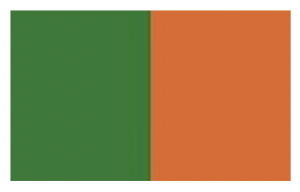On May 4, 2023, the company Amazonen -Werke H. Dreyer SE & CO. KG sought the annulment of the decision of the Fifth Board of Appeal of the EUIPO refusing the registration of international trademark No. 1461516, consisting of the combination of the colors green and orange, due to a lack of inherent distinctiveness. The mark applied for designated goods in class 7, corresponding to the following description: ‘Agricultural machines and implements, namely field sprayers.

The General Court, after examining the issue, considered that the previous decision adopted by the Board of Appeal of the EUIPO was rightly found, and therefore it dismissed the appeal filed by the applicant, due to the inherent lack of distinctiveness of the contested sign (art.7.1.b EUTMR).
However, even though the abovementioned decision regarding the lack of inherent distinctiveness had become final, the proceedings were resumed for the examination of the subsidiary claim based upon Article 7(3) EUTMR regarding the distinctiveness acquired through use.
Upon further review, the examiner rejected once again the contested trade mark because it did not meet the requirements in order to prove the distinctiveness acquired through use. The submitted evidence was insufficient as the acquisition of distinctiveness was not proven for all the EU territories. Moreover, most of the submitted evidence consisted in ‘secondary evidence’, which is not enough to prove the acquired distinctiveness.
On June 6, 2024, the applicant appealed the examiner’s decision, arguing that the acquired distinctiveness of a colour mark is more complicated to prove, and therefore the evidence of acquired distinctiveness in a given EU Member State should be presumed to apply to the remaining territories, unless otherwise is proven. In this sense, the applicant argued that the evidence of the acquired distinctiveness could be extrapolated to different EU countries if the market conditions were identical or similar to those of the country where distinctiveness had been proven.
The evidence submitted by the applicant consisted of a market survey in France, statements from different agricultural organisations in Germany, press articles, evidence of participation in trade fairs, awards, advertisements, advertising campaigns, the product catalogue, sales volumes and invoices. According to European case law, not all evidence submitted has the same probative value.
The scope of the geographical evidence must cover those territories of the EU where distinctiveness was not initially available. For this reason, the evidence submitted by the applicant is insufficient, as it is based only on a market survey in France and the declarations of German industrialists, proving the acquired distinctiveness only in two EU countries.
Although the sales volumes provided show sales in 20 different EU countries, this evidence has been rejected by the Board of Appeal of EUIPO as it is an internal document of the trade mark proprietor and does not come from a trade association (CEMA). The other evidence submitted has a secondary nature, therefore it may support the evidence submitted but has no probative value in itself. In this sense, the invoices submitted show that the trademark owner has sold many products but this does not prove that the relevant public recognises the contested sign, the same happens with the prizes, as these have been awarded for technical aspects of the agricultural machinery manufactured, but it has no relation with the contested sign.
On the basis of the submitted evidence, it is not clearly established that the colour combination applied for has acquired distinctiveness through use. The evidence submitted is insufficient in order to prove the acquired distinctiveness of the green and orange combination. Although the market survey carried out in France and the statements of the German industry show that the contested sign has acquired distinctiveness in both countries, distinctiveness had to be proven for all EU Member States, within the required time span. Furthermore, even though the applicant already has colour marks registered in the offices of several member states, the EUIPO is an autonomous system that is not conditioned by the decisions of the national systems.
In view of the above, the submitted evidence is not sufficient to demonstrate the distinctiveness acquired through use during the established period of time. Such distinctiveness has only been proven for France and Germany. Therefore, since distinctiveness acquired through use has not been demonstrated for all the EU territories, the appeal is dismissed.
Decision of the Fifth Board of Appeal of EUIPO of 3 March 2025, in case R1191/2024-5.


 Español
Español Deutsch
Deutsch